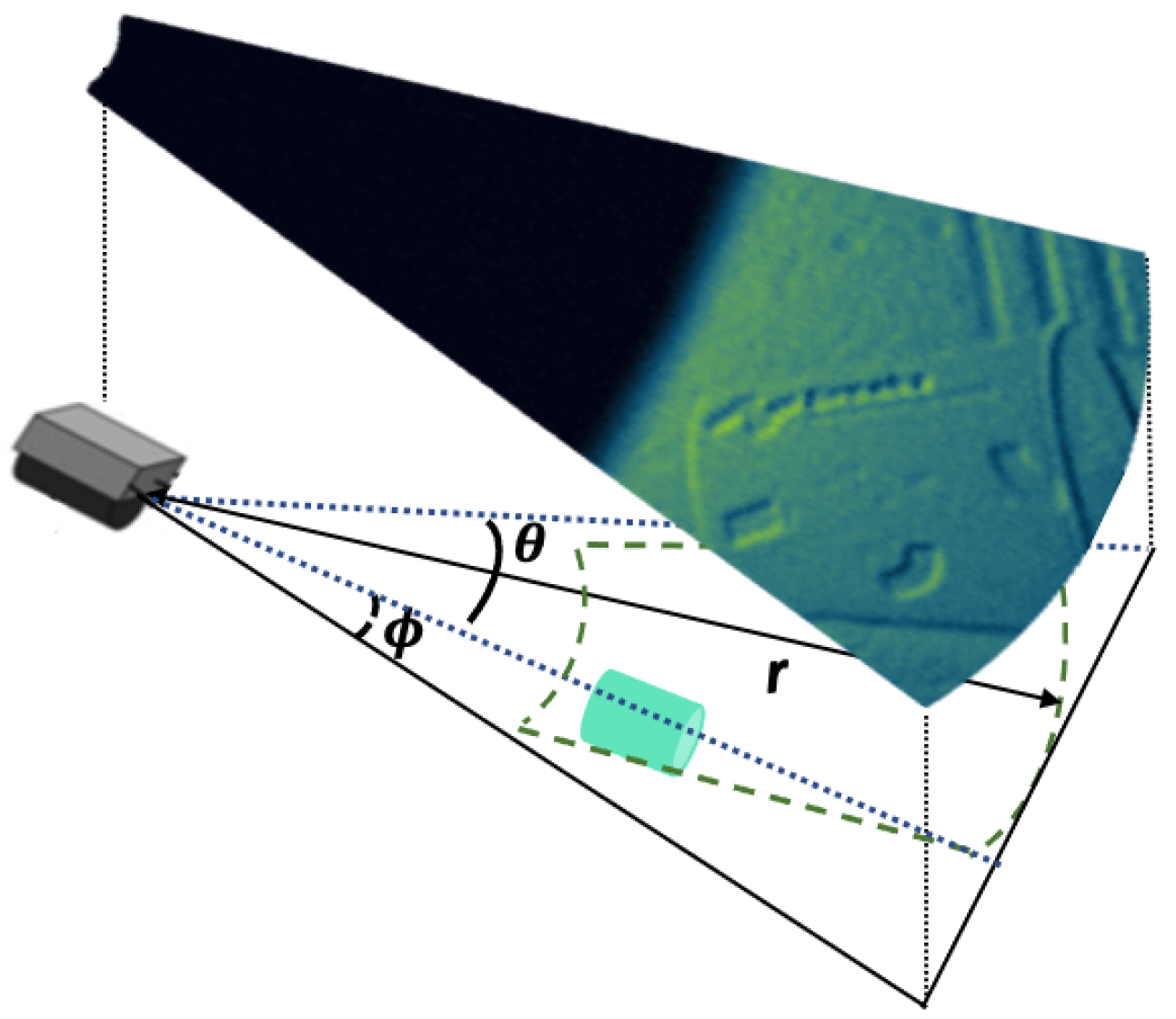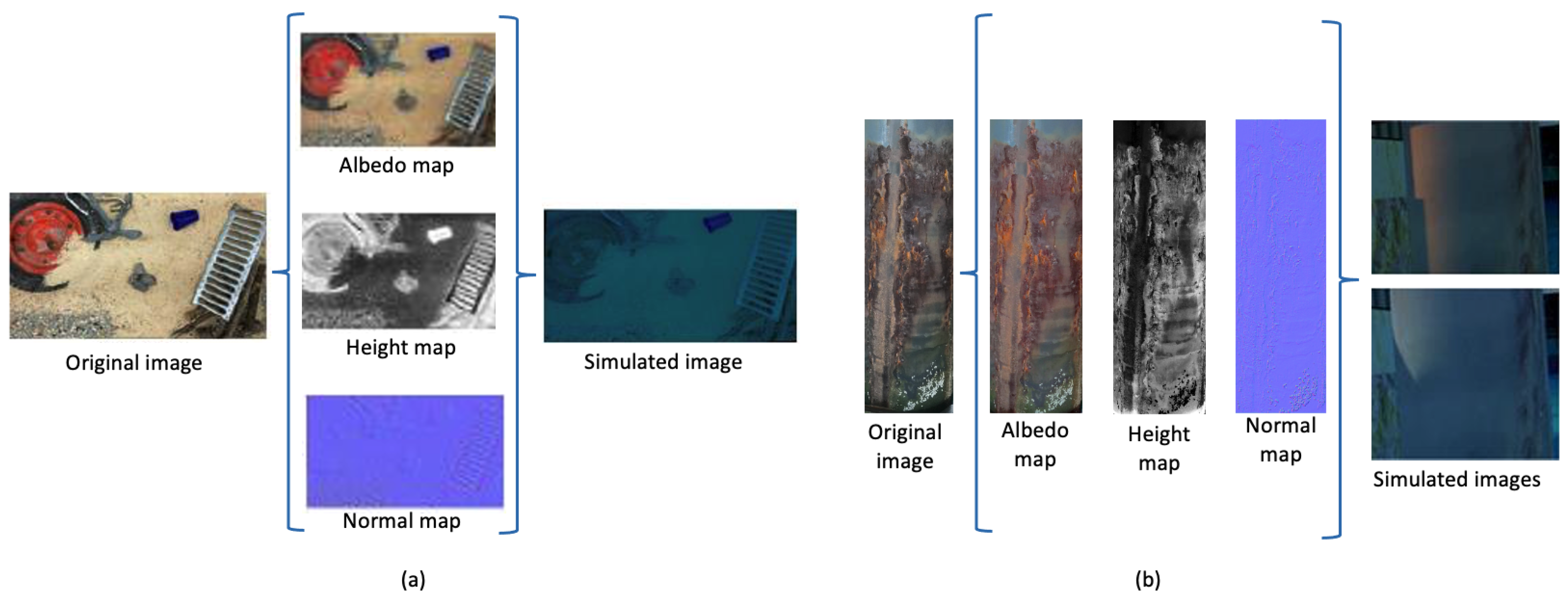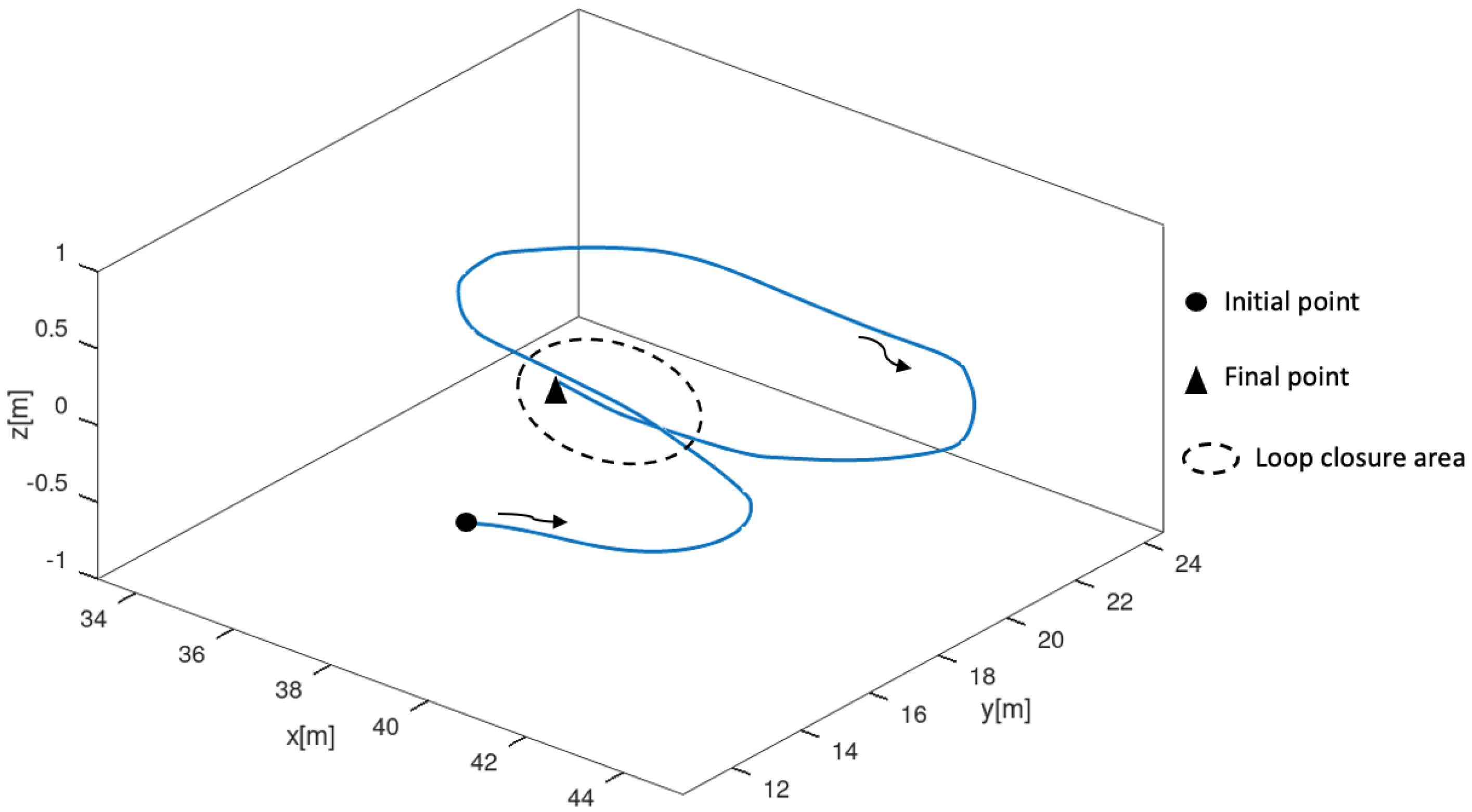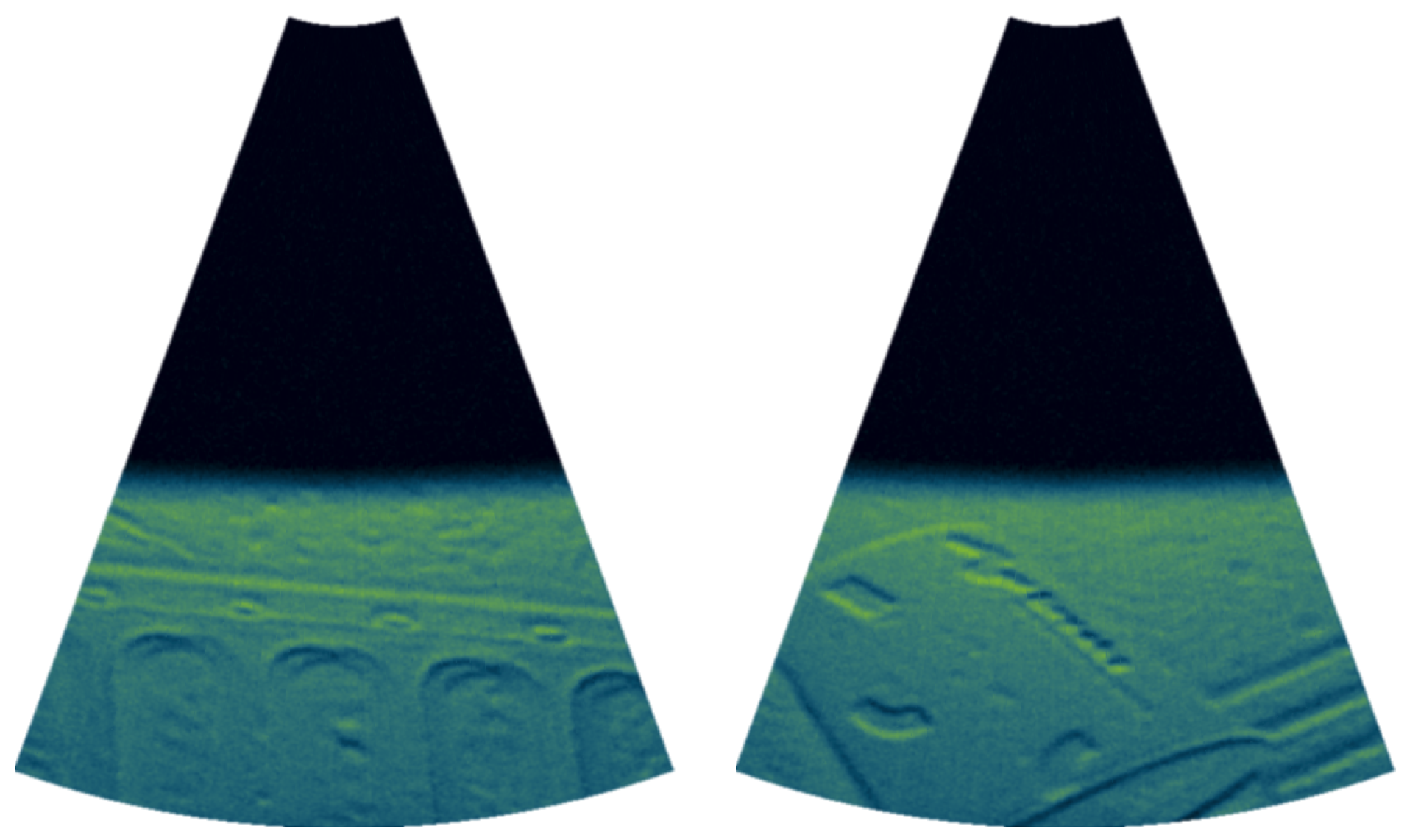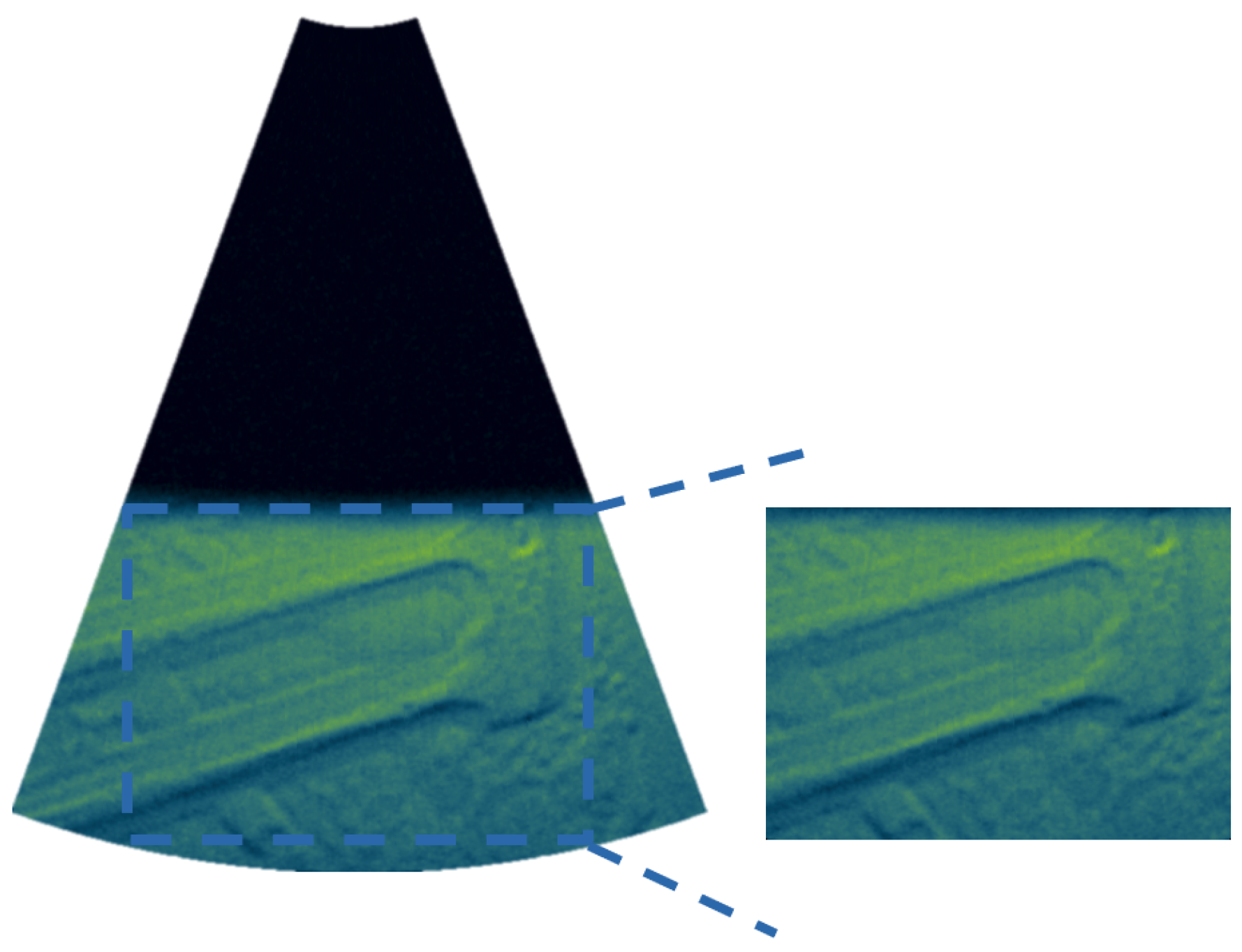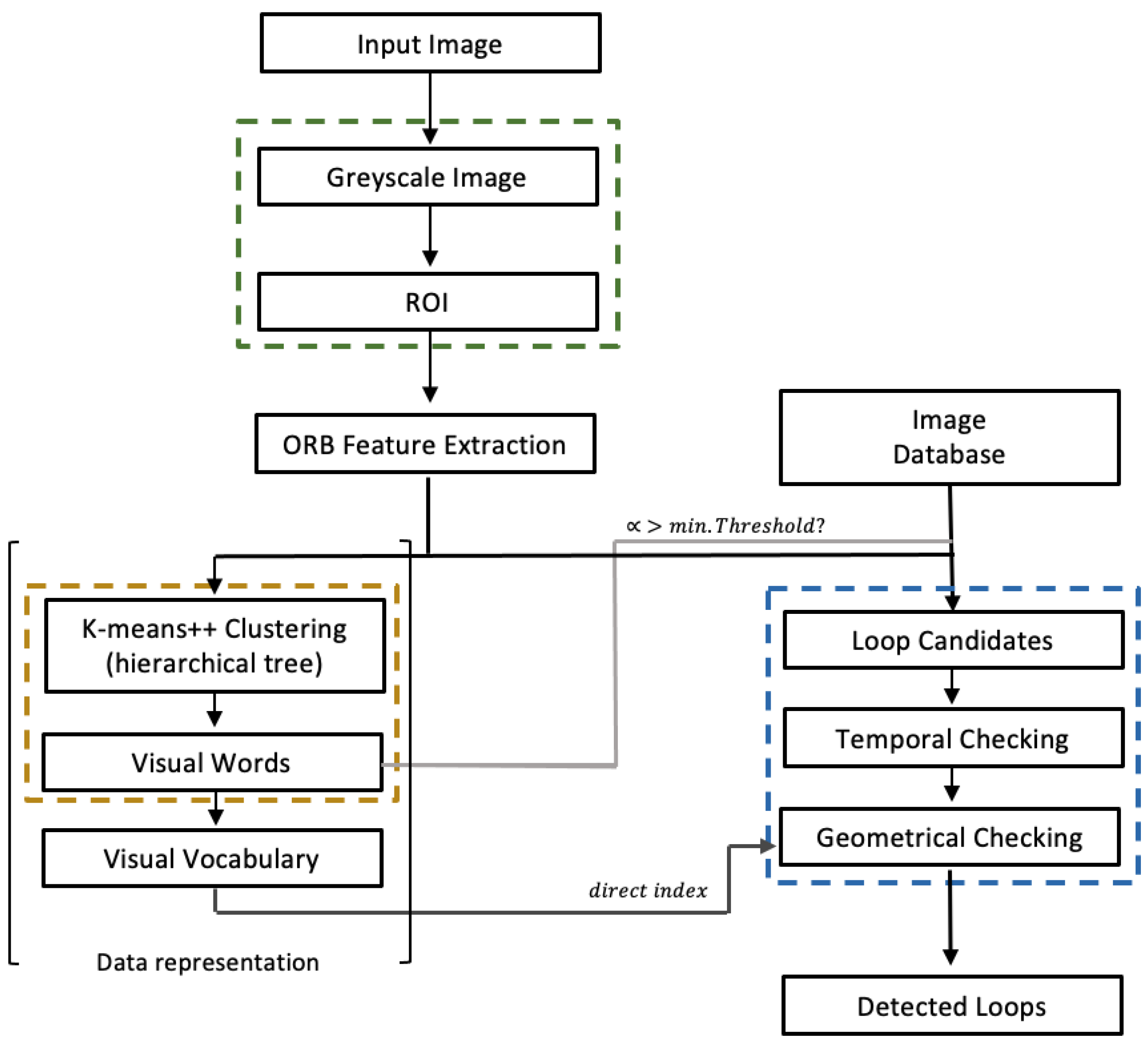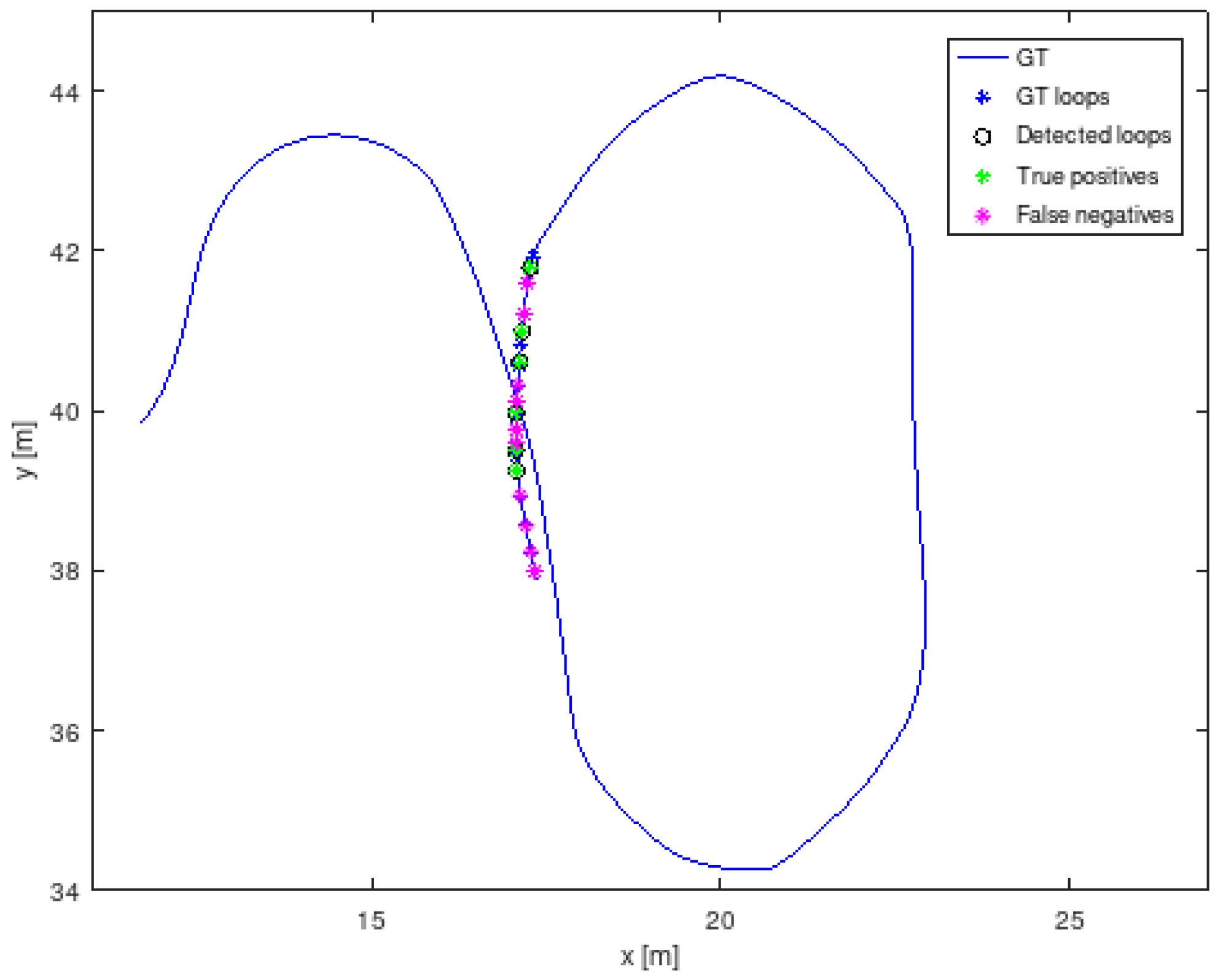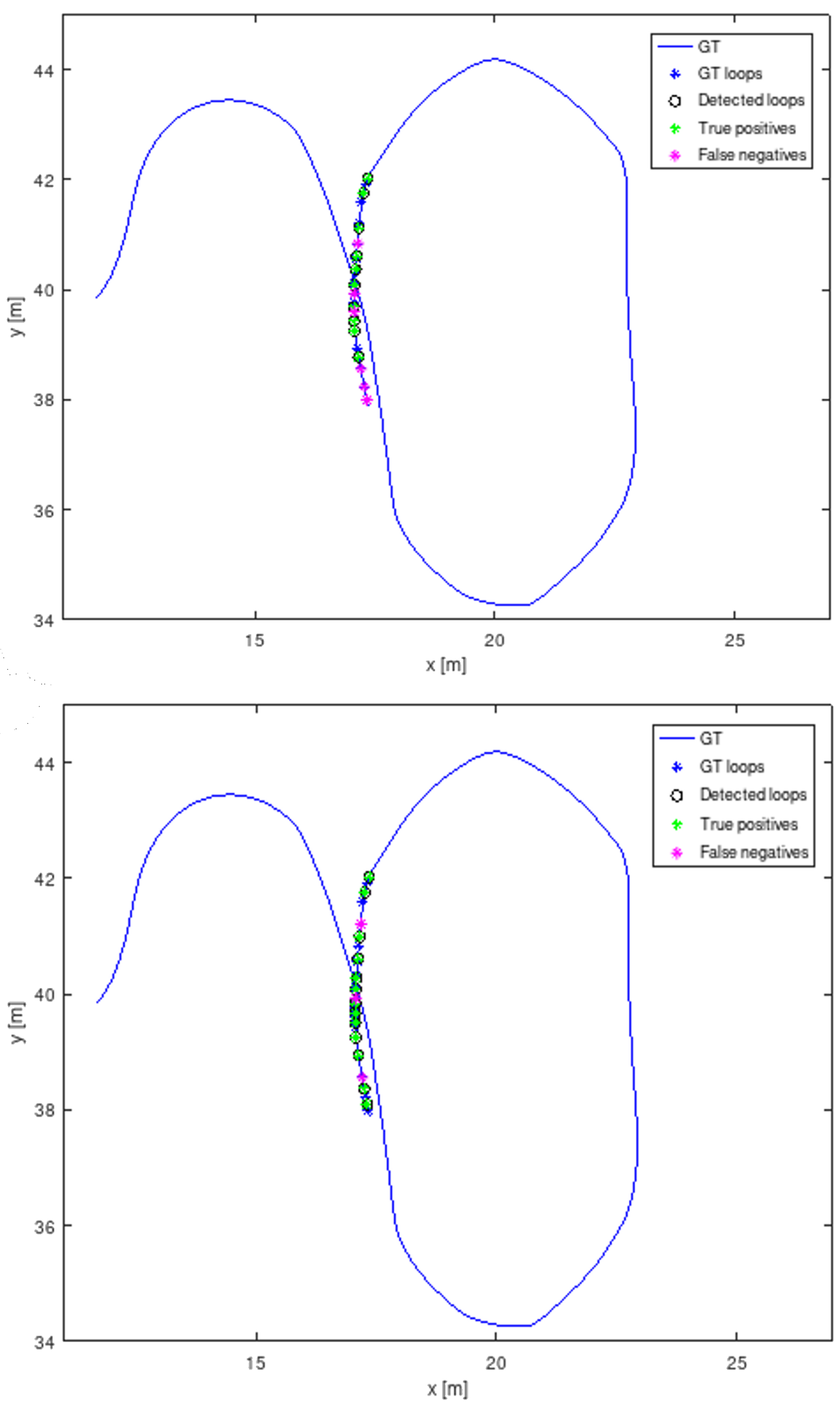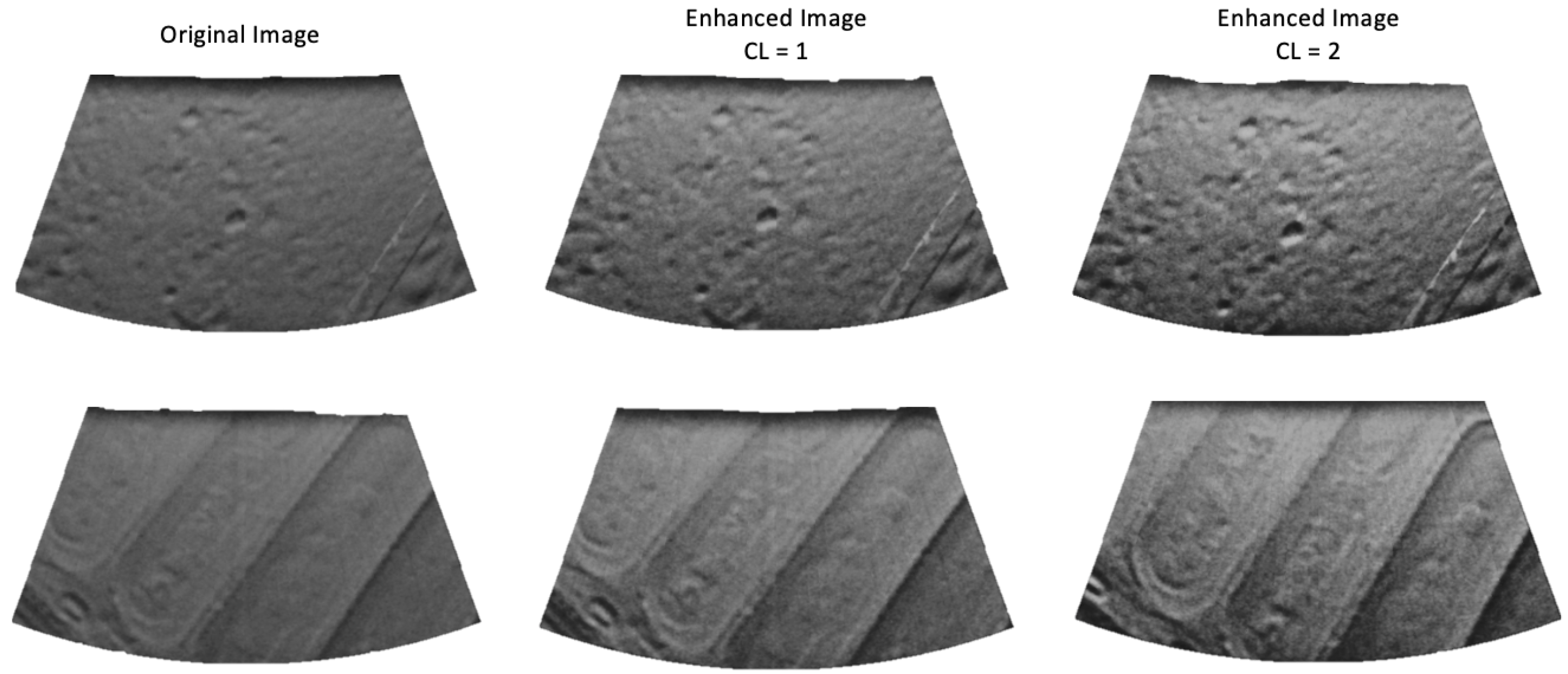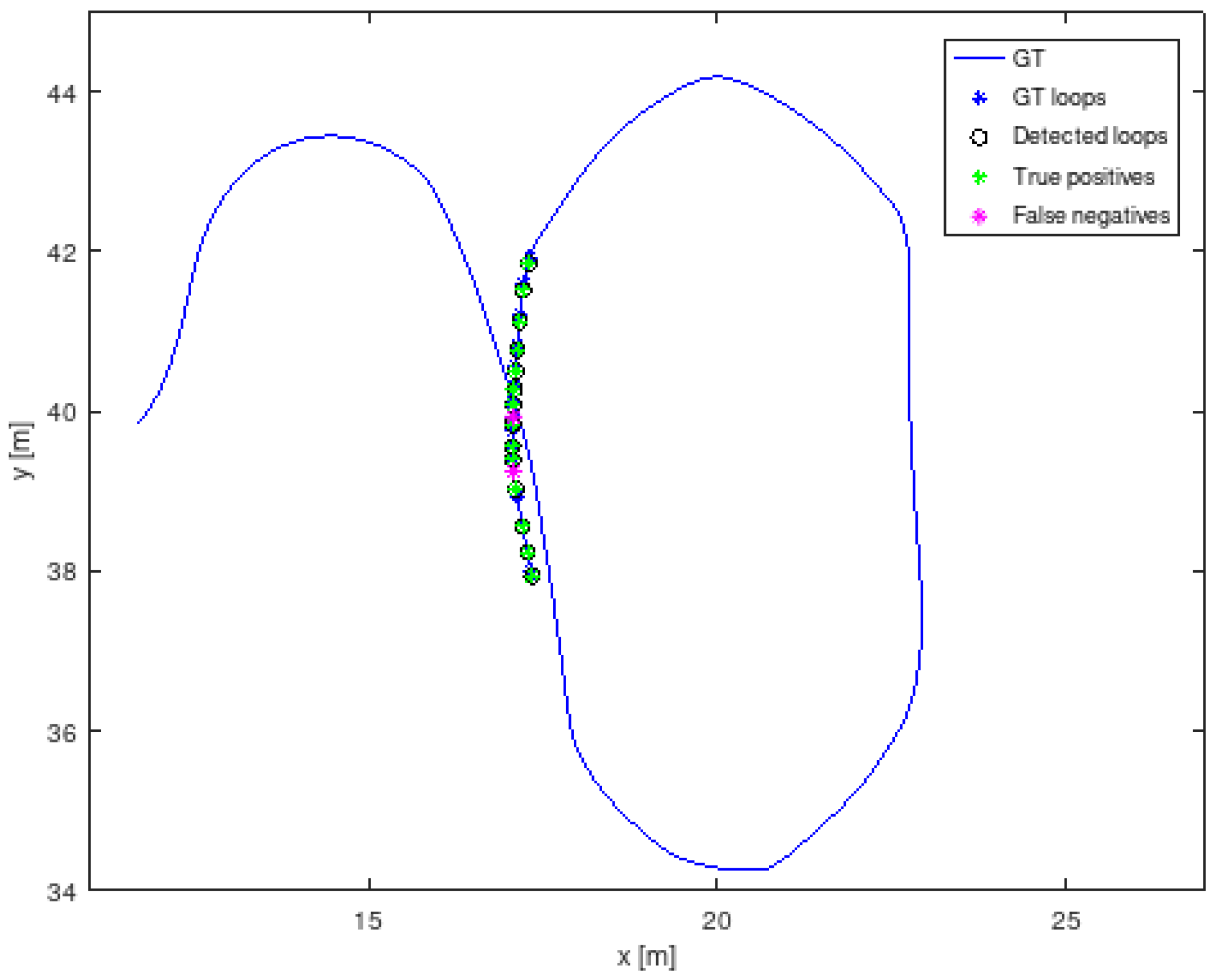1. Introduction
Harbour facilities include various structures such as quay walls and adjacent piles that need to be inspected for corrosion and damage. The inspection of these structures is normally carried out by divers and remotely operated vehicles (ROVs). However, this work is dangerous and ROVs use a cable that can restrict and complicate work in these semi-structured environments. Therefore, autonomous underwater vehicles (AUVs) have been used for these tasks. To perform an inspection, they must accurately navigate and recognise revisited places, also known as loop closure detection, to compensate for cumulative pose deviations [
1]. In an image-only retrieval model, the decision of whether the sensor has reached a revisited scene during its movement is based on similarity measures between images stored on maps. However, due to perceptual limitations, navigation near structures is still a challenge. Deep learning is a powerful technique that is increasingly used in this field of research [
2,
3]. However, it requires a large amount of data and a long training phase, which is a complex task in these semi-structured and unknown scenarios. On the other hand, traditional machine learning techniques focus on identifying previous observations, which makes the navigation principles very stationary and dependent on the representativeness of the collected observations. Although it is challenging to make this decision independently of the environment, i.e., through unsupervised learning, it is important that the vehicle continuously learns the environment during the inspection mission in order to adapt its behaviour accordingly. Vision-based systems are an attractive environmental sensing solution for robust close-range operations because they work at distances of less than 3 m (metres), provide rich information and are easy to operate [
4]. However, the underwater environment is dynamic and lacks structural features. In addition, this environment is often affected by turbidity or illumination (shallow waters), which often complicates the behaviour of navigation and mapping tasks performed by cameras, as the perception range of optical devices is severely limited in very poor visibility. Such conditions make the detection of loop closures difficult, and the vehicle may fail to detect some loops correctly or detect some erroneous loops so that the trajectory is not adjusted or adjusted incorrectly. In a previous study, the efficiency of a purely visual system for recognising similar images was analysed. This analysis showed that cameras are susceptible to strong haze and brightness conditions, achieving at best a 71% detection rate, even with enhancement techniques that provide more consistent keypoints [
5]. Today, there is a new type of sonars (SOund Navigation And Ranging) known as active sonars. They can emit an acoustic wave and receive the backscatter, so they provide acoustic images that allow them to perceive the environment, i.e., they are also called imaging sonars [
6]. Although these sensors suffer from distortion and occlusion effects due to their physical properties, they do not suffer from haze effects as the images are based on the emitted and returned sound. Therefore, this category of sonar is seen as a promising solution for these difficult environment conditions. Forward-looking sonar (FLS) and side scan sonar (SSS) are the most commonly used sonars for environment sensing. FLS is characterised by the fact that it provides a representation of the environment in front of the robot and allows overlapping images during movement. Image matching is the first problem to solve, as it is the crucial step for pose estimation or place recognition. Due to the characteristics of FLS data, namely, low signal-to-noise ratio, low/inhomogeneous resolution and weak feature textures, traditional feature-based registration methods are not yet used for acoustic images. In her work, Vilarnau [
7] proposes a pairwise registration of FLS images for the mosaic pipeline based on a Fourier method that can provide robustness to some artefacts commonly associated with acoustic imaging and noise for all image contents. For the inspection of ship hulls with FLS images, a machine learning method for the detection of loop closures based on saliency was used in 2018. To deal with the sparse distribution of sonar images, it is based on the evaluation of the potential information gain and the estimated saliency of the sonar image [
8]. Later, a loop closure detector was proposed for a semi-structured underwater environment using only acoustic images acquired by an FLS [
9]. A topological relationship between objects in the scene is analysed based on a probabilistic Gaussian function. It is based on regions with higher acoustic intensity variations, i.e., segments. The method achieves a precision of 95.38% at best and a recall of 12.24%, which is dangerous for the navigation context as there are some false trajectory adjustments and also many adjustments fail. But the performance of these sonars has greatly improved and the resolution of their images continues to increase so that the FLS can provide comprehensive underwater acoustic images. Therefore, developing efficient approaches to extracting visual data from sonar images and understanding their performance remains critical to ensure that the FLS data are suitable for the vehicle’s perception of the environment. Furthermore, these data can later be matched with the camera data if required as environment conditions change. The matching algorithms can be based on feature points and region approaches, but given the FLS characteristics and real-time constraints of underwater operations, feature point matching is more appropriate. Given the need for viewpoint invariant feature descriptors, binary methods are increasingly being used for similarity detection. These features require less memory and computation time. Proof of this was provided in underwater scenes categorised by seabed features, turbidity and illumination. Here, the Oriented FAST and Rotated BRIEF (ORB) descriptor proved to be more effective for detection and matching with the least computational time [
10]. Recently, its behaviour was also demonstrated for acoustic images using a performance comparison of different feature detectors, where ORB achieved the best overall performance [
11]. For fast and effective loop closure based on visual appearance, the bag-of-words (BoW) algorithm is often used for data representation. In this approach, the local descriptors are usually clustered using the K-Means technique and a codebook of visual words is required. Each local descriptor is assigned to the nearest centroid and the representation is in the form of a histogram. Its efficiency through inverted index file and hierarchical structures is favourable [
12,
13].
In short, the inspection of some underwater structures is crucial but still a challenge as the vehicles need to perceive the environment and get close to the object that is to be inspected. Place recognition or loop closure detection is an important task to enable successful navigation while compensating for cumulative deviations in pose estimation. But it is also a challenge as it requires the effective identification of previously seen landmarks. Typically, visibility conditions in such underwater scenarios are poor, so FLS can be a promising solution for robust loop closure detection. There are some inherent problems that make it difficult to continuously perceive a vehicle’s surroundings, such as the low and inhomogeneous resolution, which affects the visual appearance of images with weak feature textures. In addition, inhomogeneous insonification associated with the angle of incidence or tilt can also lead to occlusion-related shadows and significant changes in visual appearance, especially in semi-structured environments. However, these sensors can also be used in cloudy environments.
Therefore, this paper proposes a feature-based place recognition using only the sonar images captured by FLS. The loop closure decision is based on a continuous learning approach, i.e., an unsupervised machine learning technique, so that the scenes are continuously modelled during the mission. The idea is to apply the knowledge of the visual to the acoustic data to evaluate whether it is effective in detecting loops at close range, and then utilise its potential in conditions where cameras can no longer provide such distinguishable information. To facilitate the variation of environment parameters and sensor configurations, and given the lack of online data to fulfil the requirements in this context, a harbour scenario based on the Stonefish simulator [
14] was recreated.
The most important contributions of this work therefore include:
An evaluation of the effectiveness of extracting visual data, i.e., features from sonar images;
An understanding of the needs and behaviour of sonar deployed in the vicinity of structures;
An evaluation of a proposed visual approach to place recognition from sonar data.
The paper is organised as follows:
Section 2 describes the FLS basics and the Stonefish simulator used to capture underwater images and replicate real-world conditions.
Section 3 describes the proposed algorithm for place recognition based on forward-looking sonar data.
Section 4 describes in detail the performance metrics used. In addition, both the evaluation of the image description and matching techniques and the behaviour of the already-seen places for the different experiments performed are presented in detail. Finally,
Section 5 describes the main conclusions and planned next steps of this work.
2. Background
In most cases, sensors normally used for outdoor navigation and mapping pose several challenges when used in an underwater environment. Underwater turbidity, poor lighting conditions and particles in the water make both visual and laser-based range sensors useless. Nevertheless, the vehicles must be able to recognise their surroundings. Attention is therefore turned to sonars, as sound propagates well in water and can travel thousands of metres without losing energy, even in murky water. Active sonars, namely, FLS, allow monitoring of the environment by generating an image of the scene in front of the robot with each scan. Therefore, it is important to understand the basics of FLS before we move on to the different steps of the place recognition pipeline.
Therefore,
Section 2.1 describes the working principles of FLS devices, the generation of acoustic images and the main challenges in handling FLS images that may affect subsequent processes such as image matching and consequent decisions to close the loop. In addition,
Section 2.2 introduces the Stonefish simulator that is used to replicate the intended scenario, which includes some environment parameters and the selected FLS geometry model.
2.1. Forward-Looking Sonar
The two-dimensional (2D) FLS is a new category of sonar that can provide acoustic images at a high frame rate and is therefore also referred to as an acoustic camera. The various operating specifications, such as acoustic beam width, operating frequency, acquisition rate and beamforming, are always associated with the sensor models. However, the operation of sonars remains the same: the sonar emits acoustic waves that cover its field of view (FOV) in azimuth (
) and elevation (
), and the intensity of the returning beam is then determined based on a range (r) and bearing (
), as shown in
Figure 1.
FLS imaging projects a 3D scene into a 2D image, just like an optical camera; the depth of objects is not lost but on a sonar image it is not possible to uniquely determine the elevation angle at a given r and , i.e., the reflected echo can originate from any point in the reference elevation arc. The images are arranged and mapped in polar coordinates. In this way, the measurements of a raw image correspond to the beams in the angular direction and the range samples in the distance axis. For easier interpretation, the resulting image is then mapped to two-dimensional Cartesian coordinates, resulting in images with uneven resolution. Acoustic images are able to see through murky environments, but at the cost of a much more difficult type of data. Therefore, there are some issues associated with this type of sonar imagery that can be challenging for inspection tasks, such as:
Low resolution: Although FLSs are often categorised as high-resolution sonars, their image resolution falls far behind that of modern cameras, which typically have millions of pixels. Of course, the resolutions in the cross and down range are crucial for image quality and for distinguishing between closely spaced objects. However, the sparseness of the measurements increases with distance when they are displayed in Cartesian space. This leads to uneven resolution, which affects the visual appearance of images with weak feature textures;
Low signal-to-noise ratio: Even with a large FOV, sonar images have a high noise level due to mutual interference from sampled acoustic echoes, underwater motors near the surface or other acoustic sensors;
Inhomogeneous insonification: FLSs usually have a Time Varying Gain (TVG) mechanism with the aim of compensating for transmission losses so that similar targets located at different distances can be perceived with similar intensity. However, changing the angle of incidence or tilt can lead to variations in image illumination and other effects that depend on the varying sensitivity of the transducers or lens, which in turn depends on their position in the sonar’s FOV. These inhomogeneous intensities can influence the image matching step and, of course, the pose estimation and loop closure phases. It is recommended to configure the forward-looking sonar so that there is a small angle between the imaged plane and the bore line (grazing angle), as this allows the largest possible volume [
15]. Of course, a small angle results in a larger area with no reflected echoes in the image (black area), reducing the effective imaging area, but this configuration allows the vehicles to perform inspection tasks for structures that require close-range navigation. This is due to the fact that it also avoids shadows in the images caused by occlusions and significant changes in visual appearance;
Other artefacts: Interfering content can appear in the sonar images, which can lead to ambiguities during matching: acoustic reflections from the surface, artefacts due to reverberation or ghost artefacts. However, these interferences can usually be reduced by a suitable configuration and image composition.
2.2. Stonefish Simulator
For an initial evaluation of the feasibility of using FLS images to recognise visited places, the Stonefish simulator was used. Its main goal is to create realistic simulations of mobile robots in the ocean, taking into account the effects of scattering and light absorption. It is an open-source C++ library that makes it possible to change the position of the sun in the sky, simulate optical effects in water and also take into account the effects of suspended particles. In addition, it is possible to create specific scenarios, including one where so-called “static bodies” remain fixed at the origin of the world for the entire duration of the simulation; they are typically used for collision and sensor simulations. Static bodies include a simple plane, simple solids (obstacles), meshes and terrain.
Therefore, a harbour scenario is recreated to simulate inspection operations in port infrastructures that replicate various structures: quay walls, piers and pillars, i.e., a berth area. The ground is also simulated and consists of some objects commonly found in harbour facilities, such as garbage, amphorae, anchors and metal grids.
Figure 2 shows a wide view of the scenario of the simulated harbour facilities.
To create the real look of the structures and the seabed, a graphical material called “looks” must be created, which defines how the objects are rendered. All looks are parameterised by reflectance (colour), roughness, metallicity and reflection factor (0 for no reflection to 1 for mirror) to get a real simulation of the echoes returned by the sonar. All structures as well as the bottom are considered as rock (material) with a certain roughness and thus without metallicity factor and without reflections. To add texture to a material, both albedo and normal (or bump) maps are created based on original images to represent the appearance or texture of the scenes.
Figure 3 illustrates the entire rendering process described. The correct setting of the individual maps is crucial for successful rendering, especially the strength of the bump map. By default, the visibility conditions caused by turbidity (called “waterType”) and the sun orientation (called “SunPosition”) are set so that the simulated scenario looks sufficiently realistic, i.e., without strict visibility conditions.
The simulated AUV—Girona 500—autonomously executes predefined trajectories between different waypoints. Thus, taking into account the propulsion system of Girona 500—five thrusters—a state machine was designed for the AUV to perform an appropriate motion according to the required control motion—e.g., straight ahead or change of direction, with a certain force for a smooth navigation to collect reliable data, but also sufficient to react to the difficulties of the underwater environment (waves, currents, wind, etc.) and even the payload of the vehicle. In this context, an FLS and an odometry sensor (ground truth data) were installed on the vehicle. Both sensors were set with an acquisition rate of about 7 Hz. To simulate a mission operation, a trajectory near structures (the vehicle moves about 2–3 m away from the structures) was performed by the AUV at a fixed height, with
z set as default. The trajectory has a closed loop as the robot travels around the concrete wall and maintains the view angle as shown in
Figure 4. It moves at a speed of 0.65 metres/second (m/s) and reduces its movement speed by 0.25 m/s as it approaches a certain waypoint. If the AUV needs to change its direction of movement to reach an intended waypoint, it turns at 0.4 m/s.
The FLS is a top-down sensor, and as it is intended to provide data about the ground close to the structures under inspection, its design and configuration have been adapted accordingly. It has been configured for a range of up to 3 m (maximum measured range) at a constant standard height of 2 m above the seabed. To create good imaging conditions, the sonar was tilted by 35° and had a horizontal FOV of 40°. In addition, the sonar measurements have 512 beams and 750 bins (range resolution of the sonar image) to mimic the Gemini 720ik sonar (Tritech International Limited, Westhill, Aberdeenshire, United Kingdom) that will be used later for real tests. Thus, each sonar image consists of 514 × 720 pixels. A total of 1067 images are taken during the trajectory of the mission. Once the simulation is complete, the images and the pose for each image are saved in a folder and in a text file.
Figure 5 shows an example of the output of the sonar images.
Based on the geometry model schematically shown in
Figure 6, each FLS image covers a width of about 2 m (A) and a height of 3 m (B), i.e., it represents an area of about 6 m
2. However, there is an area without reflected echoes, which is shown as a black area in
Figure 5. Therefore, for each FLS image, a region of interest (ROI) is selected to represent the effectively imaged area of the FLS output. Thus, a bounding box of 250 × 350 pixels is used, which means that each FLS image maps an area of approximately 1.5 m
2, as shown in
Figure 7.
3. Acoustic-Based Place Recognition
In practise, place recognition is used to search an image database for images similar to a queried image in an image database. It is considered a key aspect for the successful localisation of robots, namely, to create a map of their surroundings in order to localise themselves (SLAM) [
16]. This task is therefore also referred to as loop closure and takes place when the robot returns to a point on its trajectory. In this context, correct data association is required so that the robot can uniquely identify landmarks that match those previously seen and by which the loop closure can be identified. A place recognition system must therefore have an internal representation, i.e., a map with a set of distinguishable landmarks in the environment that can be compared with the incoming data. Next, the system must report whether the current information comes from a known place and if so, from which one. Finally, the map is updated accordingly. Since this is an image-only retrieval model, the map consists of the stored images, so appearance-based methods are most commonly used. These methods are seen as a potential solution that enables fast and efficient loop closure detection—content-based image retrieval (CBIR), as this scene information does not depend on pose and consequently on error estimation. So, “how can robots use an image of a place to decide whether it is a place they have already seen or not?”. In order to decide whether an image is a new or not (known) location, a matching is made between the queried and database images using a similarity measure. The extraction of features is therefore the first step in CBIR in order to obtain a numerical description. These features must then be aggregated and stored in a data structure in an abstract and compressed form (data representation) to facilitate the similarity search. These measures indicate which places (image content) are most similar to the current place. This is an important step that affects CBIR performance, as an inappropriate measure will recognise fewer similar images and reduce the accuracy of the CBIR system.
Therefore, a tree-based approach to similarity detection for the intended context is proposed, based on the DBoW2
1 and DLoopDetector
2 libraries [
17]. This method was introduced in [
5] for optical images and is now adapted for acoustic images.
Figure 8 shows the process of place recognition based on FLS images.
For each current image, an ROI is used to discard the area without reflected echoes. Thus, each input image is “clipped” in a rectangular region to account for the effective visual information captured by FLS, as described in
Section 2.2. First, features and descriptors are extracted for each image. In this case, binary features are used, namely, ORB features. As mentioned in
Section 1, the binary methods are used because the descriptors for the features must be view invariant. On the other hand, these features require less memory and computation time. Among these methods, ORB stands out as it achieves the best overall performance. More importantly, it proves to be more effective for detection and matching with the least computation time in underwater scenes captured with either cameras covering different environment conditions or acoustic images. It responds better to changes in the scene, especially in terms of orientation and lighting. Based on these features, an agglomerative hierarchical vocabulary is then created using the K-Means++ algorithm; based on the Manhattan distance, clustering steps are performed for each level. In this way, a tree with
W leaves (the words of the vocabulary) is finally obtained, in which each word is weighted according to its relevance. Along the BoW, inverted and direct indices are maintained to ensure fast comparisons and queries, and then the vocabulary is stored (yellow block in
Figure 8). Next, marked by the blue dashed line, the ROI for each input image is used to recognise similar places, and ORB features are extracted and converted into a BoW vector
(based on Hamming distance). The database, i.e., the stored images of previously visited places, is searched for
and based on the weight of each word and its score (L1 score, i.e., Manhattan distance) a list of matching candidates is created, represented by the light grey link. Only matches with a score higher than the similarity threshold
are considered. In addition, images that have a similar acquisition time are grouped together (islands) and each group is scored against a time constraint. In addition, each loop candidate must fulfil a geometric test in which RANSAC is supported by at least 12 correspondences, minFPnts. This value is a common default value for comparing two visual images with different timestamps and therefore possibly different perspectives, resulting in a small overlap area compared to consecutive images. These correspondences are calculated with the direct index using the vocabulary represented by the dark grey link.
To measure the robustness of the feature extraction/matching and similarity detection approaches between FLS images, appropriate performance metrics are calculated. Their descriptions can be found in
Section 4.1 and
Section 4.2.
5. Conclusions
This paper presents a purely acoustic method for place recognition that can overcome the inherent limitations of perception in harbour scenarios. Poor visibility can complicate the behaviour of navigation and mapping tasks performed by cameras. Therefore, forward-looking sonars are a promising solution to extract information about the environment in such conditions as they do not suffer from these haze effects. These sensors suffer from distortion and occlusion effects. Their inherent characteristics include low signal-to-noise ratio and resolution, which is also inhomogeneous, and weak feature textures, so conventional feature-based techniques are not yet used for acoustic imaging. However, sonar performance has greatly improved and the resolution of these images is steadily increasing, allowing FLS to provide comprehensive underwater acoustic images. The proposed method aims to apply what is known about visual data to acoustic data to assess whether it is effective in detecting loops at close range, and then utilise its potential in conditions where cameras can no longer provide such distinguishable information. Given the lack of online data for these applications, and to allow for variations in environment parameters and sensor configurations, the Stonefish was utilised. Harbour facilities were simulated with this method to mimic the inspection work usually carried out in these areas. The autonomous vehicle performed a simple trajectory with a loop closure while the robot moved around the concrete wall. The vehicle navigated between waypoints close to structures, i.e., about 2–3 m, with the FLS facing the ground. Therefore, the sensor was adjusted accordingly and an odometry sensor was also used to obtain ground truth data. Considering the features that may affect the image quality and thus the subsequent imaging processes such as feature extraction and matching, the effectiveness of the acoustic features was evaluated. To this end, a functional analysis was performed to understand the performance of the ORB features. Thus, the ORB was quantified by measuring the number of detected keypoints on each image and the number of corresponding keypoints based on Hamming distance, since the features are binary. Finally, the effective matches between consecutive images, i.e., the inliers, were measured based on RANSAC, where the more similar the images are, the higher the value. The behaviour of the visual images was also measured based on these metrics to understand the performance of the acoustic images. In general, under normal viewing conditions, the sonar data provide fewer features than the camera images. However, when the visual images are made more difficult, the performance of the FLS remains the same, while that of the optical sensor decreases, reaching 18 points, of which the FLS can recognise 41 in low-light conditions. In order to understand the impact of turbidity values on the visual images, this parameter was increased in the simulator, but not for severe values. The matching performance between consecutive images decreases sharply; the algorithm detects about 80 fewer inliers compared to normal visibility conditions, suggesting that optical-based methods are sensitive to such severe conditions and may fail in detecting loop closures. Considering this degradation of visual data performance in poor visibility conditions, which is dangerous in a navigation context, it was investigated whether FLS can help find similar images in such conditions to recognise that the vehicle is already in a certain area and thus enable a correct estimation of the vehicle position. To measure the behaviour of the presented acoustic approach, the metrics precision and recall were calculated. Based on the standard thresholds commonly used for optical images, i.e., considering = 0.3 and minFPnts = 12, the algorithm does not falsely recognise situations where a loop closes, i.e., FP = 0 and 100% precision. However, the strength of the algorithm is low as it tends to lose loops along the trajectory. It only recognises six situations where loops close, achieving 37.5% of recall. This performance is unsuitable for navigation purposes as there are no adjustments to the trajectory. Therefore, the requirements for the similarity threshold and the minimum number of inliers were analysed. The lower the similarity threshold, the more situations in which the loop closes are detected by the method. Nevertheless, the performance improvements are not very significant. If the minimum value of matches between the images is lowered so that they are considered to be the same location, it is obvious that the algorithm can recognise more loop closures. However, a balance must be found to achieve a quality trade-off. With 10 inliers as the minimum threshold and = 0.3, the algorithm recognises 10 loops and achieves 62.5% recall and 100% precision. However, the experiments show that the features are not robust and therefore the matches are not distinguishable to benefit from the benevolence of the requirements. Therefore, the effect of an enrichment technique was evaluated to understand whether enrichment provides a better description of the images for acoustic image-based address place recognition. The CLAHE method was used as it was found to be the better choice for extracting additional information from low-contrast images. To improve the contrast and highlight the image edges, it depends on the parameterisation of two parameters: NT, which divides the images into equal square regions, and CL, which controls the noise enhancement. If we look at the resulting images, we can see that the contrast has been effectively increased and the details improved, so that more key points can be recognised compared to the original images. To understand whether there are any noisy pixels and whether these features are robust enough to increase the number of correct matches, we tested the behaviour of place detection for CL = 1 and CL = 2 as well as NT = [2, 3] and NT = [4, 6]. Initially, one would expect the recall to increase with contrast, but this only happens at the expense of reducing the geometric test requirements, i.e., by resorting to 10 inliers. Furthermore, the algorithm achieves the same maximum recall in two cases, but again with a lower value of inliers at CL = 2. Thus, it can be seen that more keypoints do not necessarily mean distinguishable points. Next, the number of image tiles was also increased, i.e., for NT = [4, 6], to find out whether the creation of more detailed histograms has an influence on the image description and consequently improves the similarity detection behaviour of the algorithm. In this case, increasing CL only increases recall at the expense of reducing the minimum matches for two images to be similar in content. Moreover, in this case with CL = 1, the algorithm achieves the same performance as in the previous case, but taking into account 10 inliers. It can therefore be assumed that an increase in the number of subdivisions is not accompanied by a better description of the images. In all cases, a precision of 100% is achieved, which means that there are no misidentified loops, i.e., CLAHE increases the image details and maintains the distinctiveness of the features for the similarity threshold used. Thus, the experiments show that increasing both parameters does not lead to a better description of the scene. Under the same assumptions, the most balanced result was obtained with CL = 1 and NT = [2, 3]. Under these conditions, the proposed FLS-based approach only fails for two loop closures and achieves a recall of 87.5%, which corresponds to an increase of 50% compared to the original result. The experiments show that the typically weak texture of FLS images contributes to the algorithm achieving a precision of 100% in all cases. Even if you lower the similarity threshold, this behaviour is not affected. This performance is crucial in a navigation context where the goal is to maximise recall at 100% precision, as this way no wrong trajectory adjustments are made which can lead to a wrong pose estimation of the vehicle. On the other hand, this fact complicates the strength of the algorithm not to miss any loops during the trajectory, as a minimum of consistent matches between images is required. Therefore, the enhancement technique improves the behaviour of the algorithm, i.e., it increases the image contrast and details (without noisy pixels) and more effective features are detected. For this reason, there are no features that could confuse the algorithm and thus affect its robustness in correctly recognising a place. Since the images of the FLS are based on emitted and returned sounds, the behaviour of the FLS is the same regardless of the environment conditions. This indicates that the FLS supports loop detection in poor visibility when the camera no longer provides detailed information.
In short, the place detection mechanism is therefore essential to avoid cumulative positioning errors. Indeed, visual loop detection is widely used because cameras provide a large amount of information and are very robust at short distances. However, these sensors are sensitive to visibility conditions. Considering that acoustic sensors do not suffer from these turbidity effects, this work has opened new horizons and showed that they can be of great help for underwater vehicles to perceive the environment in low-visibility conditions and thus not jeopardise the task of navigation near structures. Therefore, an adaptive navigation method can be interesting to improve the ability of vehicles to navigate in real underwater scenarios. The idea can be that the vehicle activates the most appropriate sensor depending on the conditions encountered during the mission. For example, when inspecting structures, i.e., close-range missions, the vehicle can navigate based on the camera to perceive the environment and activate the forward-looking sonar when visibility is insufficient (turbidity, darkness or brightness). If the area is poorly textured, a laser, i.e., a structured light system, can also be switched on.
New and more complex inspection trajectories are planned for the future to test the behaviour of FLS when the scene is viewed from different angles. Furthermore, other strategies to measure the similarity between images and data representation, i.e., indexing methods, will be evaluated to compare them with the performance of the proposed approach. Furthermore, it is planned to determine the conditions and limits of interaction between the two sensors—camera and FLS—in order to develop a hybrid solution for place recognition in underwater scenes. An evaluation of this approach in real harbour facilities is also planned.
